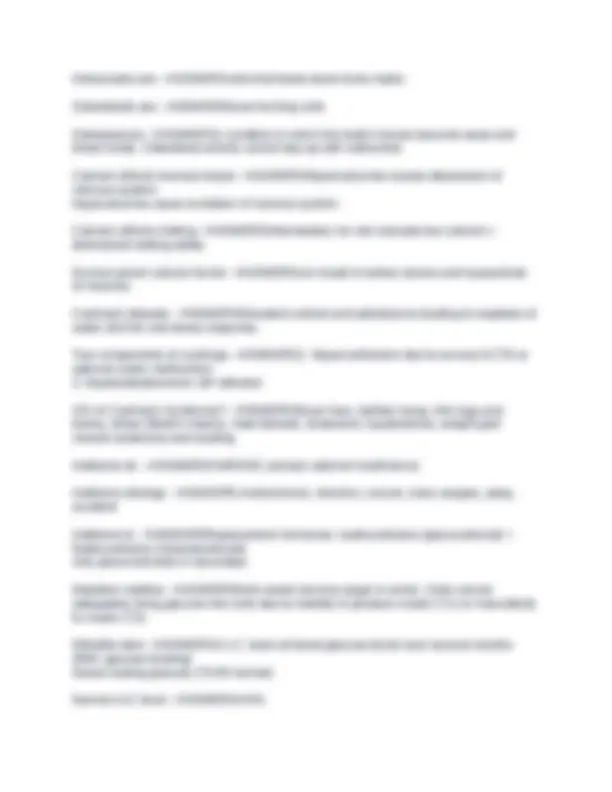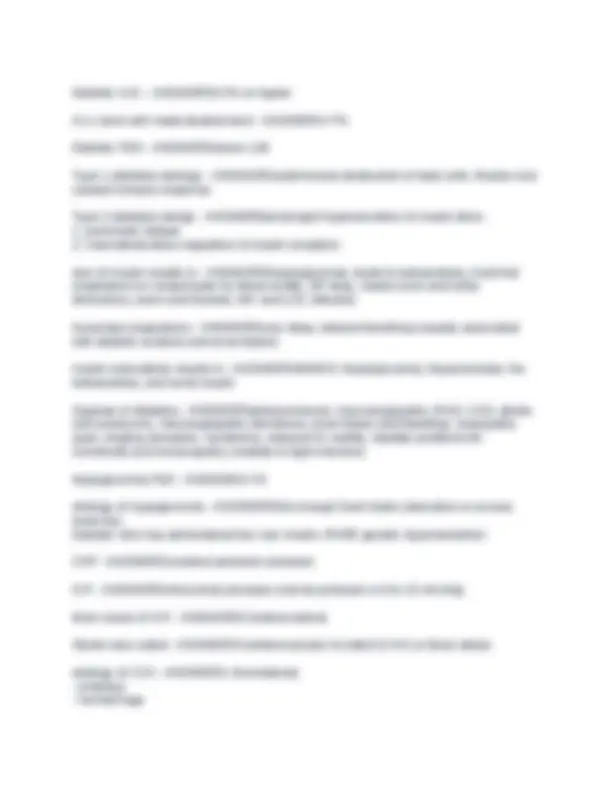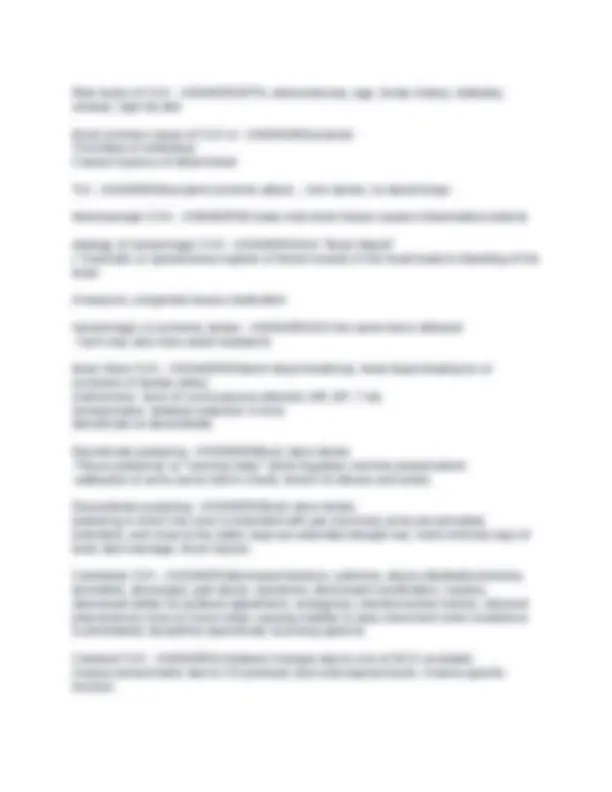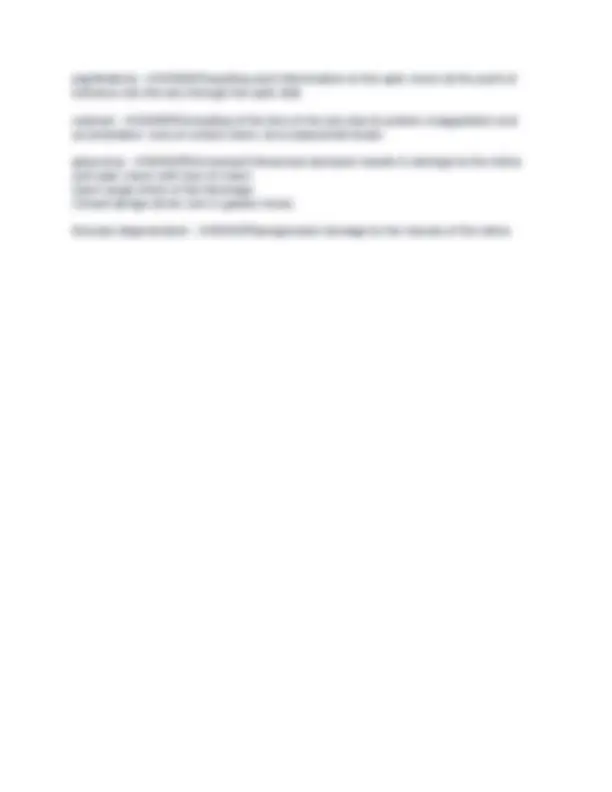






Study with the several resources on Docsity

Earn points by helping other students or get them with a premium plan


Prepare for your exams
Study with the several resources on Docsity

Earn points to download
Earn points by helping other students or get them with a premium plan
Community
Ask the community for help and clear up your study doubts
Discover the best universities in your country according to Docsity users
Free resources
Download our free guides on studying techniques, anxiety management strategies, and thesis advice from Docsity tutors
A concise overview of key concepts related to the endocrine system and neurological disorders, focusing on the pituitary gland, thyroid gland, calcium regulation, diabetes mellitus, and cerebrovascular accidents (cva). It includes definitions, explanations of common conditions, and brief descriptions of treatment options. Suitable for students studying pathophysiology, but it lacks in-depth analysis and may require further research for a comprehensive understanding.
Typology: Exams
1 / 8

This page cannot be seen from the preview
Don't miss anything!





pituitary gland - ANSWERSThe endocrine system's most influential gland. Under the influence of the hypothalamus, the pituitary Is MASTER GLAND and regulates growth and controls other endocrine glands. ACTH, TSH and ADH important in this unit. ACTH - ANSWERSAdrenocorticotropic hormone- stimulates the action of adrenal gland to secrete glucocorticoids like cortisol. ADH - ANSWERSantidiuretic hormone (vasopressin) that works on Kidney and smooth muscles. Part of RAAS. Causes vasoconstriction and reabsorption of H2O TSH - ANSWERSthyroid stimulating hormone that acts on the thyroid gland. Stimulates T3, T4, calcitonin and Thyroxine. Diabetes Insipidus - ANSWERSCaused by hyposecretion of ADH which causes little to no reabsorption of H2O. Results in polyuria, increased thirst, high B osmolarity which results in general signs of dehydration. diabetes insipidus etiology - ANSWERSTwo possible
Calcitonin function - ANSWERSLowers blood calcium levels by triggering uptake in bones. Hyperthyroidism - ANSWERSexcessive activity of the thyroid gland that can be due to cancer autoimmune dz or overactive pituitary. Hyperthyroidism autoimmune - ANSWERSGrave's dz Hyperthyroidism labs - ANSWERST3, T4 and and TSH S/S of hyperthyroidism - ANSWERSSame as hypermetabolism... agitated, exopthalmus, nervous, diarrhea, hot, ^HR, ^BP, thin, hyperactive etc.goiter thyrotoxic crisis - ANSWERSaka Thyroid storm- toxic condition characterized by hyperthermia, tachycardia, nervous symptoms, and rapid metabolism. Tx Hyperthyroid: - ANSWERSThyroidectomy, meds-radioactive iodine or thioamide (inhibits incorp of I into hormones) Hypothyroidism etiology - ANSWERSlow levels of thyroid hormone due to hypoactive thyroid gland from congenital defect, removal or destruction of arts of the gland autoimmune, endemic iodine deficiency. Hypothyroidism autoimmune - ANSWERSHashimotos Hypothyroidism S/S - ANSWERSSame as hypometabolism ie, tired, sluggish Cold intolerant obese decreased hr, p, rr Hypothroidism labs - ANSWERSlow T3/T High TSH Myxedema coma - ANSWERSextreme hypothyroidism(abrupt med cessation), rare with a high mortality rate = decreased cardiac output leads to decreased tissue perfusion which leads to brain and organ depletion leading to multi-organ failure Tx hypothyroidism - ANSWERSadministration of thyroid hormones- levothyroxine or synthroid. DOSED IM MICROGRAMS Screening at birth is mandatory. Early detection is critical to prevent mental retardation. What hormones regulate calcium? - ANSWERSparathyroid hormone and calcitonin
Diabetic A1C - ANSWERS6.5% or higher A1-c level with meds desired level - ANSWERS<7% Diabetic FBS - ANSWERSabove 126 Type 1 diabetes etiology - ANSWERSautoimmune destruction of beta cells. Maybe viral caused immune response. Type 2 diabetes etiolgy - ANSWERSprolonged hypersecretion of insulin does:
Risk factor of CVA - ANSWERSHTN, athersclerosis, age, family history, diabetes, smoker, high fat diet Most common cause of CVA is - ANSWERSischemic Thrombus of embolous Causes hypoxia of distal tissue TIA - ANSWERStransient ischemic attack....mini stroke, no dead tissue. Hemmorragic CVA - ANSWERSB leaks onto brain tissue causes inflammation-edema etiology of hemorrhagic CVA - ANSWERSAKA "Brain Bleed"
can have specific triggers tx: Immitrex/NSAIDS, avoid triggers Seizures - ANSWERS1. The sudden explosive uncoordinated firing of nerurons
papilledema - ANSWERSswelling and inflammation of the optic nerve at the point of entrance into the eye through the optic disk cataract - ANSWERSclouding of the lens of the eye due to protein coaggulation and accumulation. loss of contral vision, lens replacemet treats glaucoma - ANSWERSincreased intraocular pressure results in damage to the retina and optic nerve with loss of vision. Open angle (think of like blockage Closed abnlge (think cink in garden hose) Macular degeneration - ANSWERSprogressive damage to the macula of the retina